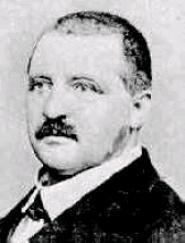Movements 6 | Catalogue WAB 26 | |
 | ||
Performed 20 November 1864 (1864-11-20): old Linz Cathedral | ||
Mass No. 1 in D minor, WAB 26 by Anton Bruckner, is a setting of the Mass ordinary for soloists, mixed choir and orchestra, and organ ad libitum.
Contents
History
After he had ended his eight-year study period with Sechter and Kitzler and he had composed a few smaller works, such as the Festive Cantata (1862) and Psalm 112 (1863), Bruckner composed his first grand Mass, the Mass in D minor. He completed the work on 29 September 1864.
The premiere of the Mass in the old Linz Cathedral on 20 November 1864 was successful. A laudatory review in the Linzer Zeitung described Bruckner's potential as a symphonic composer and ranked the D minor Mass in the highest echelon of church music.
Bruckner revised the work in 1876 and again in 1881–1882. The (small) differences between the versions concern mainly annotations about tempo, etc. For the original organ intermezzo of the Credo (after "et sepultus est") Bruckner composed an alternative with woodwind instruments, so that the conductor could choose between these two options.
Versions and editions
First version 1864, slightly revised in 1876 and 1881–82.
Setting
According to the Catholic practice – as also in Bruckner’s previous Missa solemnis and his following Mass No. 2 – the first verse of the Gloria and the Credo is not composed and has to be intoned by the priest in Gregorian mode before the choir is going on.
The work is divided into six parts:
- Kyrie – Alla breve (mehr langsam), D minor
- Gloria – Allegro, D major
- Credo – Moderato, D major
- Sanctus – Maestoso, D major
- Benedictus – Moderato, G major
- Agnus Dei- Andante quasi Allegretto, G minor veering to D major
Total duration: about 50 minutes
When compared to the previous Missa solemnis the work is more mature in conception with crescendos, which are so characteristic of Bruckner's later symphonies.
Wagner's influence is evident as the orchestra plays a major role setting the stage, developing material and intensifying the drama. ... [A] passage by way of illustrating [it] ... might be the death and resurrection section of the Credo ... The plaintive a cappella setting of 'passus et sepultus est' ... is reflected in pianissimo woodwind (or organ) and brass chorales before the strings propel a tremendous crescendo to a triumphant re-entry of the chorus at 'Et resurrexit'.
However, there is a continuity with previous works. Several passages, such as the Qui tollis of the Gloria, the central part of the Credo, and the devoutness of the word "Jesu Christe", the solemness of "cum gloria" and the dread of the word mortuorum, were already prefigured in the Missa solemnis. Moreover, the string pianissimo in the opening bars of the Kyrie was also foreshadowed in the opening bars of Psalm 146. The Qui cum Patre et Filio in the Credo is quoting the foregoing Afferentur regi.
The repeat structure already stubbed in Psalm 112 – a product of Kitzler’s tutelage – is clearly present in the work: repeat of the starting theme of the Credo in "Et in spiritum", and that of "Deum de Deo" in "Et expecto"; repeat of the "Osanna" of the Sanctus at the end of the Benedictus; and that of the ascending scale of the Kyrie, of "Et vitam venturi" and of the fugue subject of the Gloria in the Dona nobis.
Bruckner used also this ascending scale (a reminiscence of the "Qua resurget ex favilla homo reus" from Mozart's Requiem), as a stairway to heaven in i.a. the Adagio of several symphonies and his Te Deum. Its inversion, which Bruckner had used already in the first part of his Psalm 146, will be later used in the Andante of the Fourth Symphony and is also prefiguring the "Farewell to Life" of the Adagio of the Ninth Symphony.
Bruckner used a citation of the "Miserere nobis" from the Gloria in the transition to the development of the first movement of his Third Symphony. At the end of his life he made again a citation of it, as a kind of supplication, before the climax of the Adagio of his Ninth Symphony. As Nowak wrote
Perhaps the best indication of the high regard in which Bruckner held this mass is his use of the miserere-motif from the Gloria in the Adagio of the Ninth Symphony. He could think of no more fitting music for his farewell to life itself than the humbly pleading six-four chord sequences of his days in Linz.
Selected discography
The discography of Mass No. 1 is less abundant than that of the following Masses No. 2 and No. 3. Except for a partial recording (Gloria only) performed by Pius Kalt in around 1925, the first recording was taped by F. Charles Adler for his SPA label in 1954 and issued the following year. In this recording, which used Gross first edition, the "Miserere nobis" from the Gloria is sung by the bass soloist instead of by the choir. The intermezzo of the Credo is performed by the woodwind instruments.
About twenty years later, in 1972, Eugen Jochum recorded the Mass on LP (DG 2530 314). It was reissued in a LP-box together the two other Masses, Psalm 150 and several motets. The box has been later transferred to CD. According to Hans Roelofs this recording with organ intermezzo in the Credo remains the reference.
Among the about fifteen other recordings, Matthew Best's and Froschauer's recordings with organ intermezzo, and Gardiner's and Matt's recordings with woodwind intermezzo are, according to Roelofs, also excellent performances.
